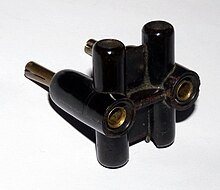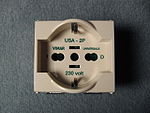Italy CEI 23-16/VII(Type L)
Side by side comparison of Italian CEI 23-16/VII plugs and sockets rated 16 (left) and 10 A (right).
The Italian earthed plug/socket standard, CEI 23-16/VII, includes two models rated at 10 A and 16 A that differ in contact diameter and spacing (see below for details). Both are symmetrical, allowing the line and neutral contacts to be inserted in either direction. The 10 A plug is called IT1-10P or S11 and the socket is IT1-16R or P11. The 16 A plug is called IT2-16P or S17 and the socket is IT2-16R or P17. This plug is also commonly used in Chile.
The 10 A style extends CEE 7/16 by adding a central earthing pin of the same gauge. Thus, CEI 23-16-VII 10A sockets can accept CEE 7/16 Europlugs. This is the plug shown in the first picture.
The 16 A style looks like a magnified version of the 10A style, identical in shape. The pins are 5 millimetres in diameter (being 4 mm thick in 10 A type), 26 mm apart center to center (while 19 mm apart in 10 A type) and 7 mm longer. The packaging of these plugs in Italy may claim they are a “North European” type. In the past they were also referred to as per la forza motrice(for electromotive force, see above) or sometimes industriale (industrial), although the latter has never been a correct definition as factories used preminently three-phase current and specialized connectors. Big appliances are usually sold with schuko plugs, so 16 Ampere non-rewirable plugs are only used in adapters and power cords. Those appliances are always earthed, so unearthed 16A plugs are now very uncommon, and only a few brands still sold them in rewirable version.

Old adaptor from «forza» to 2׫luce» and 1׫forza»
The double standard was initially adopted because in Italy, up to the second half of the 20th century, the electric power used for lamps and the one used for all other appliances were sold at different tariffs, charged with different taxes, accounted with separated electricity meters, and sent on different wire lines that ended with different sockets. Even though the two electric lines (and respective tariffs) were officially unified during the summer of 1974 many houses kept twin wires and twin electricity meters for years thereafter (in some zones of Lazio the 127V network was provided for lighting until 1999). The two gauges for plugs and sockets thus became a de facto standard which is still in use today and has been standardized with CEI 23-16/VII. Older installations often have sockets that are limited to either the 10A or the 16A style plug, requiring the use of an adapter if the other gauge needs to be connected. Numerous cross adapters were used.
CEE 7/16 unearthed Europlugs are also in common use; they are standardized in Italy as CEI 23-5 and fit most of the appliances with low current requirement and double insulation.
Appliances with CEE 7/7 Schuko-French plugs are often sold in Italy too; however most sockets will not accept them since the pins of the CEE 7/7 Schuko-French plugs are thicker than the Italian ones. Adapters are cheap and commonly used to connect CEE 7/7 plugs to CEI 23-16/VII sockets, but they cannot exceed 1500 Watts and they could make an unsafe connection in some cases.
The current Italian standards provide for sockets to have child-resistant shutters (“Sicury” patent )
Italian multiple standard sockets
Bipasso socket (#1) and Italian adapted Schuko (#2) in a modern installation.
Italian VIMAR universale socket accepting CEE 7/4 (German), CEE 7/7 (German/French), CEE 7/16 (Europlug), CEE 7/17 (German/French unearthed), NEMA 1-15 (USA/Japan), CEI 23-16/VII 10 and 16 A Italian plugs.
Given that the plug with which appliances are fitted and sold varies, in modern installations in Italy (and in other countries where CEI 23-16/VII plugs are used) it is usual to find sockets that can accept more than one standard.
The simpler type has a central round hole and two 8-shaped holes above and below. This design allows the connection of both styles of CEI 23-16/VII plugs (10 and 16 A) and the CEE 7/16 Europlug. The advantage of this socket style is its small, compact face. VIMAR brand claims to have patented this socket first in 1975 with their Bpresa™ model; however soon other brands started selling similar products, mostly naming them with the generic term presa bipasso (twin-gauge socket) that is now of common use.
A second, quite common type looks like a CEE 7/4 (German) socket, but adds a central earthing hole. This design can accept CEE 7/4 (German), CEE 7/7 (German/French), and CEI 23-16/VII Italian 10 A plugs. Some of these sockets may also have 8-shaped holes to accept CEI 23-16/VII Italian 16 A plugs as well. Its drawback is that it’s twice as large as a normal CEI 23-16/VII italian socket.
Other types may push compatibility even further. The VIMAR-brand universale (all purpose) socket, for example, accepts CEE 7/4 (German), CEE 7/7 (German/French), both CEI 23-16/VII italian 10 and 16 A plugs, and also NEMA 1-15 (USA/Japan) plugs.
|






